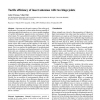Free Online Productivity Tools
i2Speak
i2Symbol
i2OCR
iTex2Img
iWeb2Print
iWeb2Shot
i2Type
iPdf2Split
iPdf2Merge
i2Bopomofo
i2Arabic
i2Style
i2Image
i2PDF
iLatex2Rtf
Sci2ools
BC
2004
2004
Tactile efficiency of insect antennae with two hinge joints
Antennae are the main organs of the arthropod tactile sense. In contrast to other senses that are capable of retrieving spatial information, e.g. vision, spatial sampling of tactile information requires active movement of the sense organ. For a quantitative analysis of basic principles ofactivetactilesensing,weuseagenericmodelofarbitrary antennae with two hinge joints (revolute joints). This kind of antenna is typical for Orthoptera and Phasmatodea, i.e. insect orders that contain model species for the study of antennal movements, including cricket, locust and stick insect. First, we analyse the significance of morphological properties on workspace and sampling acuity. It is shown how joint axis orientation determines areas out of reach while affecting acuity in the areas within reach. Second, we assume a parametric set of movement strategies, based on empirical data on the stick insect Carausius morosus, and investigate the role of each strategy parameter on tactile sampling performan...
BC 2004 | Joint | Joint Axis Orientations | Tactile |
| Added | 16 Dec 2010 |
| Updated | 16 Dec 2010 |
| Type | Journal |
| Year | 2004 |
| Where | BC |
| Authors | André Frank Krause, Volker Dürr |
Comments (0)

